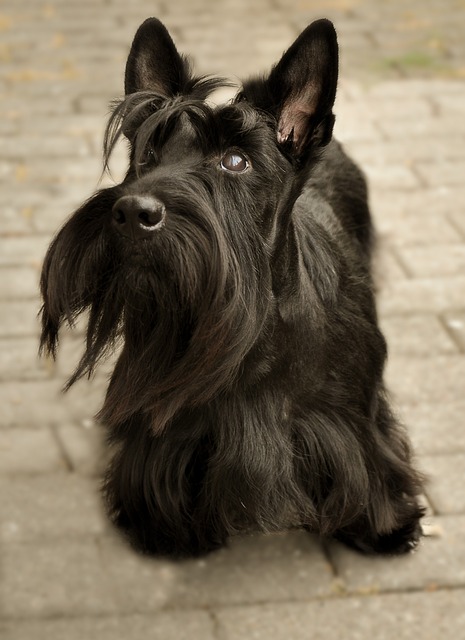


The Scottish Terrier, also known as the Scottie, is a small but sturdy terrier breed that originated in Scotland. They are known for their distinctive appearance, characterized by their pointed ears, bushy eyebrows, and wiry coat. Scottish Terriers are affectionate and loyal companions, known for their independent nature and strong-willed personality. Despite their small size, they have a bold, confident attitude and make excellent pets for owners who enjoy a dog with personality and character.
The Scottish Terrier has a long history, dating back to the early 19th century in Scotland. Originally bred for hunting small game such as rats, foxes, and badgers, they were used primarily by farmers and hunters. They were developed from various terrier breeds, including the Cairn Terrier and the Skye Terrier. Over time, the breed became popular among the Scottish aristocracy and was eventually recognized by dog kennel clubs. Their distinct appearance and tenacious temperament made them a favorite among dog lovers around the world.
The Scottish Terrier is a compact and muscular breed, typically standing around 10 inches (25 cm) tall at the shoulder and weighing between 18 to 22 pounds (8 to 10 kg). They have a characteristic wiry coat that comes in several colors, including black, brindle, and wheaten. Their coat requires regular grooming to maintain its distinctive texture. They have a broad, wedge-shaped head with sharp, erect ears and dark, almond-shaped eyes that give them a dignified and alert expression. Their tails are often carried erect, adding to their proud demeanor.
The Scottish Terrier is known for its confident, bold, and independent nature. While they are affectionate with their families, they tend to be reserved around strangers. Scotties are typically very loyal and enjoy spending time with their human companions, but they can be stubborn and strong-willed, requiring a firm hand in training. They can also be a bit aloof, especially with other dogs, and may not always be friendly with pets that are not part of their family. However, with proper socialization, they can become well-behaved and amiable companions.
Scottish Terriers are active dogs that enjoy regular exercise, although their small size means they don't require as much physical activity as larger breeds. A daily walk, combined with some playtime in a secure area, is typically enough to keep them happy and healthy. They enjoy outdoor activities and are particularly fond of exploring their environment. While they are not hyperactive, regular exercise is important to keep them mentally and physically stimulated, as they are an intelligent breed prone to boredom.
Training a Scottish Terrier can be a challenge due to their independent and stubborn nature. They are intelligent dogs, but they tend to have their own ideas and may not always follow commands right away. Early socialization is essential to help them become well-adjusted and comfortable around other animals and people. Positive reinforcement methods work best with this breed, and patience is key. They respond well to short training sessions with rewards, but owners should be consistent and persistent to ensure good behavior. They may be difficult to house train, so it's important to start early and remain consistent.
The Scottish Terrier is generally a healthy breed, but like all dogs, they can be prone to certain health issues. Common health concerns include hip dysplasia, allergies, and certain types of cancer. Regular veterinary check-ups and a balanced diet are important for maintaining their overall health. Grooming is a significant part of caring for a Scottish Terrier, as their wiry coat requires regular brushing and trimming. Their ears should be checked regularly for signs of infection, and their teeth should be brushed to maintain good oral health.
The typical lifespan of a Scottish Terrier is around 12 to 15 years. With proper care, including regular exercise, a healthy diet, and routine veterinary visits, they can live a long, happy life. Like many small dog breeds, Scotties tend to be relatively long-lived compared to larger breeds, and they can continue to be active and playful well into their senior years.
© copyright Dog Compendium 2024 - 2025